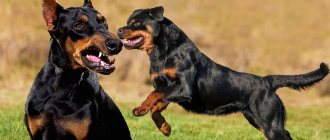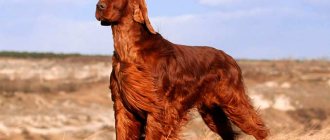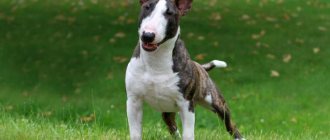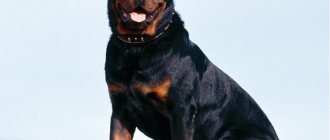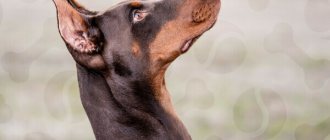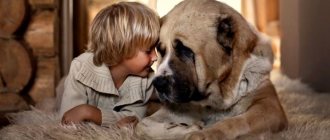The Doberman is a strong and intelligent dog. The breed was bred for service purposes, but now these dogs are not as aggressive as before. They are graceful, smart and loyal. Often used for guarding or protection, but can become a companion or pet. They have a very keen sense of smell and a developed instinct to protect their territory. Therefore, the Doberman breed has remained one of the most popular for many years.
- Head
- Training
- Nutrition
Content
- The main character traits of a Doberman: female or male?
- Doberman character
- Basic commands
- Raising a dog
In this article you will learn what features of character and behavior are inherent in the Doberman. After studying this information about the temperament and disposition of a Doberman at different ages, you will get an idea about the breed. Find out how the character of a bitch differs from the behavior of a dog. We hope our article will help you figure out which gender of puppy is best for you.
From Germany to the Book of Records
And the Doberman began its victorious march around the world. A certain Otto Geller, originally from the same town of Apolda, enthusiastically continued the work begun by Friedrich. And soon Dobermans, having captured Germany, began to appear in other European countries, and then infiltrated the American continent. Why do dogs of this breed attract people so much? Probably, first of all, because Friedrich Louis’s dreams of breeding a simply evil dog did not come true. Through the efforts of breeders and amateur enthusiasts, the Doberman eventually turned into a very beautiful, elegant and physically strong dog. But external data is not the main thing. A properly trained dog makes an indispensable guard, capable of standing up for itself and its owner if necessary.
Did you know about this? The tick is a professional bloodsucker
One of the representatives of this breed even got into the Guinness Book of Records as the best bloodhound. It was a Doberman named Sauer, who in 1925 tracked down a thief by scent alone, walking 160 kilometers with the police!
The main character traits of a Doberman: female or male?
The Doberman puppy is an active and restless pet. If you take care of and train your puppy, you can avoid pampering. Constant damage to things does not indicate the baby’s bad character, he is just very active and needs somewhere to throw out his energy. You can buy toys for him, he will be active with them, direct his energy to playing with them. Already from 3-4 months (the time of socialization), he is able to perceive the general rules of education. At this time, it is important to begin socializing and training the dog.
Bitch: character
There is an opinion that Doberman females have a more submissive and gentle character. But experts believe that character largely depends on heredity and individual characteristics. There are always exceptions, bitches with a very difficult character, and there are males with an easy-going and submissive character. But still, there is a difference in the behavior of the sexes. There are advantages and disadvantages for female and male genders.
Advantages:
- Strong relationship with owner and home
- Emotionally sensitive perception
- Girls are smarter and smarter than boys
- Accepts training tasks well
- During walks, he runs less in the bushes
- Doesn't rush at strangers
- The breed is ideal for breeding, just one assessment from the exhibition is enough
Flaws:
- Sly
- Periodic menstruation
Hunger
The Doberman loves to be praised and is ready to go out of his way to get his owner's approval. As one of the books about Dobermans rightly says: “The positive aspects of the history of the Doberman look so attractive that it has a negative effect - people refuse to believe that a dog can have such a big and loving heart.” There are real legends around the world about the sincere devotion of Dobermans - both funny and sad. One of these tragic stories occurred during the terrible period of the siege of Leningrad.
In the half-strangled city, hundreds of people died every day from hunger and bombing. But, despite the lack of food, which drove some townspeople to crime, everyone’s favorite, a Doberman named Dar, still lived in one family.
Did you know about this? Homosexuality among animals
However, sooner or later something happened that was bound to happen. The head of the family was admitted to the hospital with a standard diagnosis: extreme exhaustion due to chronic malnutrition. His wife went to the hospital every day, but the doctors could only tell her one thing: there was no improvement and was not expected, the end was already near, and hunger was to blame for everything. Having learned that a dog still lives in these people’s apartment, the attending physician said that, perhaps, only she could save her owner.
Male: character
Advantages:
- High performance, very durable
- Solid appearance, a big plus for exhibitions
- Persistence in achieving results in the learning process
Flaws:
- Independent and more stubborn than a girl. Requires more strict training than a girl.
- To fulfill your physical and natural needs, you need a longer time for walks. According to physiology, he is not capable of quickly emptying the bladder.
- Can run away from its owner if it smells a female in heat.
- During the period of estrus in females, fights with other males are possible.
Is it possible to influence and correct the character of the Doberman?
Raising and training a Doberman is of great importance, as soon as you bring him into your home. Do not allow people to chew things, stop attempts to pester strangers while walking, do not allow them to eat from someone else’s hands, pick up food from the floor, or beg for food from you while eating. It is forbidden to jump on and bite people, even to show your love. Only training and proper upbringing will change a dog’s character for the better. The puppy training process is based on the method of motivation, encouragement and praise. It is prohibited and unacceptable to treat the dog harshly during training.
Care
The Doberman is an unpretentious pet. He lives well in an enclosure or in a house. Despite its overall dimensions, the dog does not require much space. If you walk him enough, he will be calm at home and will not misbehave or impose his company. Caring for an adult dog is also easy. Dobermans are distinguished by good health and unpretentious diet. They have short hair, no dog smell, and shedding is moderate.
You need to walk your dog at least 2-3 hours a day. In winter, you need to wear warm overalls, since Dobermans do not have an undercoat and do not tolerate cold well. If the dog lives outdoors, protection from the sun is necessary. And for the winter, the pet must be taken indoors.
Hygiene procedures are the same as for other short-haired dogs. It is necessary to periodically wipe it with a damp cloth and comb it with a stiff brush. After a walk, be sure to wash your pet’s paws and, if necessary, chest and belly. Full bathing is recommended several times a year.
Your pet's eyes and ears require care. They need to be wiped regularly and inspected for inflammation. Otitis often develops in uncropped ears. To prevent the formation of tartar, you need to brush your teeth regularly. It is especially important to monitor the condition of the puppies’ mouths, preventing inflammatory processes.
Nutrition
You need to carefully select food for your Doberman. There have been cases of gastric volvulus due to inappropriate feeding. Suitable nutrition will prevent overeating, but will be able to provide your pet with all the necessary substances. It is best to choose premium or super-premium complete dry food designed for large breeds. It could be:
- Purina® PRO PLAN;
- Royal Canin;
- Hill's;
Dry food should not be mixed with regular food. If the owner chooses natural food, meat should occupy the main place in it. You need to know how much of it an adult pet needs - at least 500 g per day. You should also give vegetables, cereals, fermented milk products, cottage cheese, and boneless fish.
Health
Doberman Pinschers are strong pets; when properly maintained, they live a long time and suffer little illness. Common pathologies of the breed are:
- elbow dysplasia;
- heart rhythm disturbance;
- narcolepsy;
- allergic diseases;
- musculoskeletal injuries.
To avoid illness, you need to regularly take your pet to the veterinarian. Before six months, the puppy must have all its vaccinations. Regularly treat your pet for fleas and ticks. And deworming 4 times a year.
To decide whether to get a dog of this breed, you can watch the video:
Doberman character
The Doberman is usually friendly and becomes very attached to its owner and his family members. Has moderate aggression and moderate excitability. The Doberman is a service dog, so it is necessary to take an obedience course and pay attention to the presence of a protective and fighting instinct, firmness and courage of character. Of particular importance for exhibition animals is self-confidence and courage while maintaining good contact with the owner.
Advantages and disadvantages
Everything about the Doberman breed can be understood by studying the pros and cons. The main negative quality can be considered an aggressive disposition. But even this can easily be turned into a positive quality if you raise your pet correctly.
In contrast to the disadvantages, this breed has a lot of advantages:
- The Doberman is a dog that many call the most loving and faithful.
- Despite its impressive size, it will treat all family members with kindness.
- It is almost impossible to unbalance a representative of this breed; he will bare his teeth, but will not attack without a good reason.
For reference! Some inexperienced dog breeders confuse the Miniature Pinscher with the Doberman Pinscher, but these are different breeds.
External similarities between miniature pinscher and doberman
How to raise a Doberman puppy
If you train your pet correctly, then over time you will get an obedient dog that will follow all commands and delight you every day. Experts believe that several factors may influence the Doberman's susceptibility to following various commands:
- pet's temperament - the speed of the pet's reaction to stimuli, both positive and negative;
- character - how exactly the dog resists various unpleasant influences;
- obedience - the dog’s ability to accept human leadership;
- vigilance - the speed with which the dog notices potential danger, both in relation to itself and in relation to the owner;
- aggressiveness - the pet’s ability to react hostilely to potential danger;
- curiosity - interest that is developed when a dog feels, hears and sees something;
- sociability - the ability to interact with people;
- possessiveness is the interest shown by animals in certain objects, for example toys.
How quickly your dog will learn commands depends on which traits predominate in the character of a Doberman puppy. By paying attention to the character traits of your animal, you can find an approach to it and adjust its behavior in certain situations.
- Eagerness will get you nowhere . You should not try to teach a Doberman puppy all the commands at the same time; you need to learn the commands one by one. You need to have patience and act methodically. You should not scold your pet at the moment when he makes mistakes, and when he succeeds in something, then the pet should be encouraged.
- Don't hit . It is prohibited to use physical punishment against a pet. You should limit yourself to variable intonation, but avoid shouting. After the Doberman puppy turns three months old, it is allowed to use a light spank as punishment while saying the phrase “Ugh.” It is necessary to punish immediately when the animal commits an offense, and not after it, since the animal simply will not understand what exactly it was punished for.
- Subsequence . The main goal is to ensure that the pet follows the command the first time. Commands should be pronounced clearly and in an even voice so that the dog understands and obeys you. All family members should be involved in raising the dog, but they must act together. It is forbidden to allow situations in which you scold the puppy, and another family member praises him or simply does not pay attention.
- Pamper . Remember to reward your Doberman puppy with a variety of treats and praise when he has done what is asked of him.
Breed standard
Dobermans are fairly large, elegant dogs with a strong build. But they are not massive, rather graceful. They are characterized by nobility of posture and endurance. They have a proportional build, harmoniously combining power with elegance and even sophistication. The height of Dobermans is above average - for males 68-72 cm, for females 63-68 cm. Weight is 40-45 kg, for females - 32-35 kg.
The appearance of Dobermans has remained almost unchanged since their creation. Only now has tail and ear docking, originally adopted by the German standard, become optional. In some countries, this procedure is even prohibited, so docked dogs may be disqualified at international exhibitions. The current standard, adopted in 2015, recognizes both options.
Head
The head is proportional in shape and size to the body. When viewed from above, it has a wedge-shaped elongated shape. The line of the crown is straight, the stop is clearly defined. No drooping cheeks. The mouth is wide, the jaws are well developed. The teeth are strong, with a scissor bite. The nose is wide, almost square, black. Brown individuals may have a lighter color. The eyes are oval, medium-sized, and should be dark in color. But light-colored dogs can be light brown.
The ears are set high. Uncropped - medium in size, hanging, the leading edge is adjacent to the cheeks. But for many, the appearance of a Doberman with cropped ears is more familiar. Then they are erect, pointed upward, and mobile.
What a dog's head should be according to the standard can be seen from the photo:
Head
Head
Torso
Dobermans have a strong build and strong bones. These are lean, hardy and strong dogs. Proportional build is expressed in the fact that they have an almost square body - the height at the withers is equal to the length of the body.
The neck is long, muscular, straight. The withers are prominent, the loin is short, the croup is rounded. The chest is wide, convex, the stomach is tucked. The tail is set high, and when docked it is very short - only 2 vertebrae remain. If a Doberman has an undocked tail, it is long, thin,
Limbs
Legs are straight, vertical, well developed. The front ones are set parallel, at right angles to the body. Their length is proportional. The hind legs have clearly defined muscles, rounded hips and knees. The paws are short, gathered into a ball. The movements of these dogs are light and sweeping. They run fast, but elegantly and beautifully.
The photographs show what a Doberman should look like according to the standard:
Rack
Appearance
Doberman ear and tail docking
Previously, the ears and tail of Dobermans were always cropped. The tail was shortened some time after birth; only 2 vertebrae were supposed to be left. The ears are cropped later, at 1.5-2 months. Now this procedure is common only in Russia and the CIS countries.
Docking is rarely performed on adult dogs, as it is more difficult for them to endure anesthesia and post-operative recovery. It is necessary to use a special device to ensure that the ears become correctly. Some dogs have to wear such a crown for several months. Therefore, before docking, you need to think about whether it is worth torturing your pet like this. If he will not be exhibited, you can leave his natural ears and tail.
In many countries, docking has not been carried out since the 80s of the 20th century. This procedure is considered cruel, which is why representatives of this breed with undocked ears and tail are common. The standard recognizes both options, but at German and other European shows, docked individuals may be disqualified.
From photographs of purebred representatives of the breed, it is clear that both cropped and natural ears are allowed:
Docked
Undocked
Coat and color
The fur of representatives of this breed is short, hard, and thick. It fits tightly to the body, smooth and shiny. There is no undercoat. Now there are 4 common colors of Dobermans: black and tan, brown, blue and fawn. Initially, when the breed appeared, only one color was recognized. Therefore, black Dobermans are still the most common.
A mandatory sign of the breed are rusty marks on the legs, chest and face. They must be clearly expressed, with a certain pattern. Such spots can only be located in certain places. At the beginning of the 20th century, brown and tan and blue colors were recognized. The deer color appeared only in the 70s. This is a light sand or grayish-yellow color.
The photo shows that the color of representatives of the breed can be not only black, brown, blue and even white are allowed:
Black, brown, blue and white colors
Serious guys...
Vices
By the appearance of a Doberman, you can immediately determine if he has deviations from the standard. Disqualifying faults include soft wavy fur, the presence of undercoat, light eyes, and malocclusion. There cannot be white markings in the color. And height should not deviate from standard values by more than 2 cm.
Basic commands
You will use some commands more often, others less often. But they will still come in handy to easily interact with the Doberman and even keep him safe in various situations.
- Aport. One of the most difficult teams. Many people perceive it as very easy and simple, but with many dogs you will have to work hard. This skill is used for other exercises: searching, searching, selecting an item and many others. Usually they are all used in service. When working out a command, “Aport” and “Give” are used, and a gesture is also used.
- Give. On the command “Give” the dog must give up the object.
- Lie. A connecting command that needs to be learned for other commands. In addition, it will not interfere at home or on the street.
- To me. You will need to use this command quite often. So start with it immediately after your Doberman puppy has learned his name. Never call the dog to punish, and do not scold if it comes on its own, even after mischievousness before it. This behavior on your part may alienate the animal.
- Place. A puppy or an adult dog must clearly know where his place is located. He can sleep anywhere, if you allow it, of course, but he must know this command. You can use it outside the home, marking the place with a leash or your favorite toy.
- Near. It is possible to teach your pet the “Near” command at any age, be it an adult dog or a small puppy. When you move to a new home, you should immediately think about training your puppy.
- Sit. One of the very first commands that a Doberman puppy should learn.
- Stand. The command is useful in everyday life, for example, for combing a dog.
- . The prohibiting command is one of the most mandatory and taming it begins from the first day the puppy appears in the house. Requiring the command “Fu!”, “No!”, “No!” - immediately stop the unwanted action.
Breed traits
Breed traits (on a 5-point scale)
| Doberman (Doberman pinscher) | |||
| Activity | in the house | 2.9 | |
| on the street | 4.3 | ||
| Obedience | training | 4.2 | |
| strangers | 4 | ||
| Domination | in family | 2.1 | |
| over dogs | 2.8 | ||
| Defending your territory | from people | 3.5 | |
| from dogs | 3.6 | ||
| Sociability | in family | 4.9 | |
| with strangers | 3.1 | ||
| with dogs | 3.2 | ||
| Concentration | in family | 1.1 | |
| in front of strangers | 2.2 | ||
| with dogs | 2 | ||
| Aggressiveness | in family | 1.1 | |
| to strangers | 2.6 | ||
| to the dogs | 2.5 | ||
| to cats | 3 | ||
| Family behavior | calmness | 4.5 | |
| demand for affection | 4.6 | ||
| excitability | 4.1 | ||
| playfulness | 4.3 | ||
| excessive barking | 2.1 | ||
| behavioral breakdowns | 2.2 | ||
| Tolerance for children | up to 4 years | 3.4 | |
| over 4 years old | 3.8 | ||
| Institutional use | watchman | 4.7 | |
| bodyguard | 3.5 | ||
This breed is often compared to the following dog breeds: German Shepherd, Great Dane, American Staffordshire Terrier, Bull Terrier, Rottweiler.
Photos show how beautiful and elegant Dobermans are:
Raising a dog
Education is the process of shaping Doberman behavior acceptable to the owner, when this behavior is not regulated by commands. During upbringing, a dog develops relationships with its owner, family members, passers-by, behavior in the house, on the street, and relationships with other dogs. The training process begins immediately when the dog first appears in the house and continues throughout the dog’s life. Regardless of the dog's breed, it must be trained. Just as people do not like ill-mannered people, dogs should also know what is allowed and what is not allowed. Raising a dog is a rather complex process, which is not limited to learning just a few commands. The main goal of education is that the dog should become pleasant to talk to. In addition, it must be manageable at some points, otherwise it will be very difficult for the dog owner. In the broadest sense of the word, dog training is about teaching the dog commands such as “Bad” and “No”. But besides this, the dog must know what is good and what is bad, even in those moments when the owner is not around. Some believe that the Doberman only understands commands, but cannot generalize. Only those who, as a rule, never had dogs, and studied them only in laboratory conditions, in which dogs were not able to show their full potential, are convinced of this, as well as those who, due to their personal qualities, were unable to establish a relationship with pet. In real life, the Doberman is a pack animal and therefore, like any other pack animal, needs to communicate with members of its family. In this situation, the dog’s family members are people. It is quite stupid to think that if a dog caresses you, this means that his skin is itching. In order for a dog’s nervous system to function normally, it needs affection, love, communication, and praise. In addition, so-called “inhibiting factors” are required, because if the dog is allowed everything, then this will not lead to anything good. When raising a Doberman puppy, you should pay attention to the genetic characteristics of the breed. A family is a pack in which there must be a leader, in this case the leader is a person. The leader punishes, plays, feeds, caresses, praises and scolds. All other members of the owner's family are ranked by rank. At that moment, while the puppy is small, all other family members are senior to him. However, in the process of growing up, around the age of one year, the dog begins to look for its place in the hierarchical pyramid. Naturally, she will try to take the step that is as high as possible. She can do this with the help of force, in the case of large dogs, or with the help of cunning, as small dogs do. The more ill-mannered the dog is, the more difficult this process will be. If the owner from the first days shows his pet that the one who has the power is right, then he will turn out to be a frail neurotic or an evil beast with whom you will hardly communicate with joy. A Doberman puppy must understand that he must obey people, since they love him, feed him, and raise him. Understand that prohibitions are not the whim of the owner, but a way to protect everyone from trouble. The main influence on the dog should be the voice. From the first days of being in your home, the puppy must realize that you love him, and if you raise your voice, then this means that he is doing something wrong. One of the best incentives for a pet is considered to be a treat, which should be given out for good behavior and listening to commands.
Story
The Doberman is a German dog, its homeland is Germany. The creator of the breed, Karl Louis Dobermann, served in the night police and was a tax collector. He decided to breed a dog that would help him in his difficult service. According to his idea, it should be a small, smooth-haired dog, physically tough and smart. Appearance was not taken into account, the main thing was performance.
Dobermann began breeding at the end of the 19th century. No records were kept, so it is unknown what breeds were used. Probably, pinschers, shepherd dogs, Great Danes, Pointners, Rottweilers, and mastiffs participated in the breeding. Just 20 years later, in 1890, an amazing dog was created that immediately became popular. It was bought for security and police service. At first the breed was called the Thuringian Pinscher. After the death of the creator, “Doberman” was added to the name “pinscher”.
Otto Geller continued the work of Dobermann. He softened the aggressiveness of the new breed a little and made the dogs more obedient and kind. It is he who is considered the creator of the modern breed; under him, these dogs spread throughout Europe. Already in 1899, a club for Doberman Pinscher lovers was created.
Dobermans appeared in Russia at the very beginning of the 20th century. At first they were used for service in the police and army. But due to the revolution and civil war, representatives of the breed were almost destroyed. And during the Great Patriotic War, these dogs were actively used at the front. Dobermans served as sappers, scouts, and messengers.
The breed survived after World War II thanks to the efforts of dog breeders from the USA. In the middle of the 20th century, the word “pinscher” was removed from the name. Now the breed is called "Doberman". This is the only breed named after its creator. She was recognized and officially entered into the register in the Pinscher and Schnauzer section. It belongs to the group of working breeds.
For many years now, the breed has been one of the top popular pets and is included in the top ten smartest dogs. Since the 70s of the 20th century, Dobermans have been bred not only for official purposes, they have become pets.

